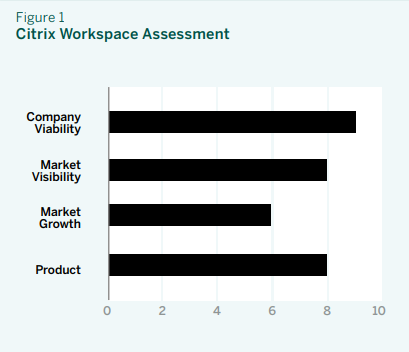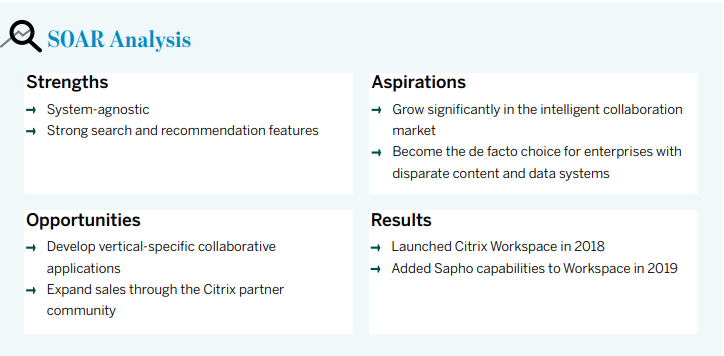Citrix Workspace - Vignette by Deep Analysis
Founded 1989 | HQ Fort Lauderdale, FL | 8,000 employees (approx.) | $3B revenue (est.) What Citrix has done well is to build a niche for itself, targeting workers and enterprises that leverage multiple, fragmented applications and products, and delivering a platform that can intelligently unify otherwise awkward situations.

Citrix Systems, Inc was founded in 1989, with headquarters in Fort Lauderdale, Florida. Led by CEO David Henshall, Citrix has revenues of approximately $3 billion and around 8,000 employees. At its core, Citrix provides technology for employees to access corporate applications and work anywhere on any device. In 2011, the company acquired EFSS start-up ShareFile, following that up in 2012 by acquiring Podio, a start-up that provided an enterprise collaboration system. In 2018, Citrix added Sapho, a microapp platform. Today, these technologies have been united into the company’s flagship offering, Citrix Workspace – a unified platform for work, with enhanced security including single sign-on and micro-VPN capabilities to ensure secure access to critical applications and content. Depending on the package, Workspace includes unified secure access to Software as a Service (SaaS) and web apps, Citrix virtual apps and desktops, Citrix Content Collaboration (formerly ShareFile), and Citrix Endpoint Management, along with advanced intelligence features.

By integrating key technologies including content collaboration, microapps, and workflows into Citrix Workspace – a SaaS application – the Citrix vision is to evolve the virtual workspace to make it more intelligent and collaborative. The Workspace platform is aimed at meeting the needs of the “intelligent assisted worker,” providing contextual and personalized files, data, and information to enable high productivity. Though we call Workspace an application, it is, in a broader sense, a collaborative platform reminiscent of an enterprise portal – one that can be developed/configured to meet differing needs, drawing on scattered, currently siloed applications and information stores, and presenting them to the worker in a unified and easy-to-use virtual workspace.
On a conceptual level, Workspace is a layered system that Citrix describes as a secure container that first connects, aggregates, and orchestrates disparate data sources. These data sources could be in the form of files from a storage system, identity management, business applications, or graph data. On top of this aggregated data, Workspace provides orchestration, automation, and analysis in the form of recommendations and insights. Beyond this are built-in user behavior analytics, access control, and data protection services. Important to note here is that the data sources that Citrix accesses may be legacy applications in the cloud or on-premises. The “secure container” layer of the architecture provides centralized, coordinated integration and federation capabilities.
At the next conceptual level up the Workspace stack, Citrix adds productivity management functionality. This comes in the form of unified search, work management, notifications, and simple workflows (for example, approval processes). We would argue that there is an apparent similarity between the increasingly ubiquitous Microsoft Teams application and Workspace. And one could justifiably compare the two; however, there is a crucial differentiator with Workspace. Though one can subscribe to and use the standard Citrix Workspace user interface, its true value for larger organizations is that the Workspace functionality can be embedded and exposed as services in the customer’s system of choice. Going back to the first layer in the Workspace stack, though Citrix has its EFSS system (ShareFile), for example, the system is essentially agnostic. It can access any common data source at the back end, and it can expose the Workspace environment in any front-end system of choice (including Microsoft Teams). Taking the agnostic concept forward, Workspace can be used as a development platform to build a single centrally managed, collaborative application – one that is composed of disparate and disconnected bestof-breed applications and data sources.

Finally, of particular note in our analysis of Workspace is its focus on providing intelligent search capabilities. These go far beyond traditional federated search, in that – leveraging the 2018 Sapho acquisition – Workspace offers a form of virtual assistant that personalizes a recommendation feed by taking note of, for example, recent applications of files accessed, and adding, in effect, relevancy and intent to its recommendations. The result is that Workspace can essentially filter out irrelevant notifications and information for the digital worker. These features can be further developed (using low-code) as micro applications.

Citrix, and specifically ShareFile and Podio, has come a long way. Going head-to-head against the likes of Microsoft or Box as a pure-play collaboration or EFSS system was never going to work out well. What Citrix has done well is to build a niche for itself, targeting workers and enterprises that leverage multiple, fragmented applications and products, and delivering a platform that can intelligently unify otherwise awkward situations. That was the goal of enterprise portal vendors in the dotcom era, but they were far too early to market and unable to deliver on their promises. Citrix Workspace appears to offer a collaborative and productive yet – importantly – pragmatic platform that recognizes the legacy chaos and lack of cohesion that is normal within most, if not all, enterprises and work environments.
Figure 1 shows our assessment of Citrix Workspace across four categories.

Many organizations are not pure-play Microsoft environments; rather, their applications and data silos are varied and diverse. Citrix provides a comparable alternative or augmentation to Microsoft Teams. In situations where O365 is not the preferred corporate option and/or there is a mix of third-party repositories, Citrix is worth looking at. Similarly, the agnostic nature of Workspace both at the back and front ends means this platform offers a range of possibilities for developers and thirdparty partners to build their own specialized collaborative applications.

About Deep Analysis
Deep Analysis is an advisory firm that helps organizations understand and address the challenges of innovative and disruptive technologies in the enterprise software marketplace. Its work is built on decades of experience in advising and consulting to global technology firms large and small, from IBM, Oracle, and HP to countless start-ups. Led by Alan Pelz-Sharpe, the firm focuses on Information Management and the business application of Cloud, Artificial Intelligence, and Blockchain. Deep Analysis recently published the book "Practical Artificial Intelligence: An Enterprise Playbook," co-authored by Alan and Kashyap Kompella, outlining strategies for organizations to avoid pitfalls and successfully deploy AI. Deep Analysis works with technology vendors to improve their understanding and provide actionable guidance on current and future market opportunities. Yet, unlike traditional analyst firms, Deep Analysis takes a buyercentric approach to its research and understands real-world buyer and market needs versus the “echo chamber” of the technology industry.

Alan Pelz-Sharpe
Alan Pelz-Sharpe is the founder of Deep Analysis. He has over 25 years of experience in the IT industry, working with a wide variety of end-user organizations like FedEx, The Mayo Clinic, and Allstate, and vendors ranging from Oracle and IBM to startups around the world. Alan was formerly a Partner at The Real Story Group, Consulting Director at Indian Services firm Wipro, Research Director at 451, and VP for North America at industry analyst firm Ovum. He is regularly quoted in the press, including the Wall Street Journal and The Guardian, and has appeared on the BBC, CNBC, and ABC as an expert guest.